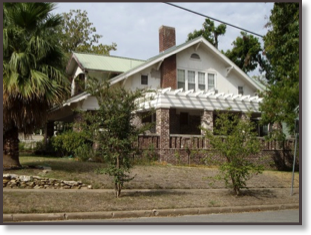Old Judges Hill Historic District
A Proposed Austin Local Historic District
Brady House - 1915

Historic Use: Residence
Current Use: Residence
City of Austin Historic Landmark
John W. Brady (1876-1945) and this address are first listed in city directories in 1916. In 1920 he is indicated as the owner. From 1929-1940 he is listed with his wife Nellie, and his occupation is indicated as lawyer. John W. Brady is listed in 1906-07 as County Attorney (Brady & Caldwell), h 913 Colorado. 1910: special assistant attorney general, r 913 Colorado. 1914: Brady - (Lightfoot, Brady & Robertson) r. W. 6th; no listing for 1601 Pearl.
The current owner bought the property from a group of artists and entertainers called Imagine, Inc. Dee McCandless, a dance choreographer of some note, was among that group. “At that time, the house was divided into 12 rooms. The porches had been enclosed and a room had been added on the Southwest corner. The residents before that were a family named Butler. They lived here for over 20 years and raised a family in the house.
Significant Persons Associated with Building
1916-1945: Judge John W. Brady (1876-1945) had a much larger house behind this one at the corner of 16th and West where apartments now stand -- 1606 West, which had served as the home of John Chiles. He sold that house and built this one as a downsizing measure in 1916.
Brady was one of five children born in Austin to James and Agnes Brady. His father was a grocer, born in Ireland, and his mother was English. Brady received a law degree from UT in 1896. He began his career in a law partnership with E.B. Robertson of Fort Worth. Later, as county attorney of Travis County, Brady was the driving force behind the dissolution of the Standard Oil Company’s monopoly in Texas. The state of Texas awarded him $90,000.00 for the effort. He also worked as special counsel for Governor “Ma” Ferguson. Subsequently he became the assistant attorney general, served as an attorney for the State Banking Board, and was appointed justice of the 3rd Court of Civil Appeals in Austin (1918-1923), but was defeated for election in 1923.
There is a less glamorous chapter in John Brady's life. At the age of 60 he had a young paramour for whom he secured a job at the state capitol. Lehlia Highsmith was a stenographer for the Supreme Court Commission of Appeals. She “was found in the company of other men” and was stabbed to death on November 9, 1929, in front of her boarding house. Brady was incarcerated the next day.
His wife, Nellie Burns Brady (1876-1945), testified that since Brady’s defeat in the re-election, her husband had been on a 10-year downward spiral of drinking and infidelity. Dr. Goodall Wooten testified that Brady was an alcoholic. Brady pleaded temporary insanity caused by chronic drinking and was tried twice – the first trial in Austin resulted in a deadlocked jury in Austin; the second trial was in Dallas, where he was convicted of murder without malice and sentenced to prison for three years, though he served less than two years, from January 28, 1931 to July 1932, having whittled off more than a year with credits for his work as a penitentiary school teacher among other jobs.
Brady’s wife stood by him through the ordeal, and he returned to his wife at 1601 Pearl after prison and engaged in legal research until his death. Mrs. Brady died in September of 1945. Judge Brady died the following December.